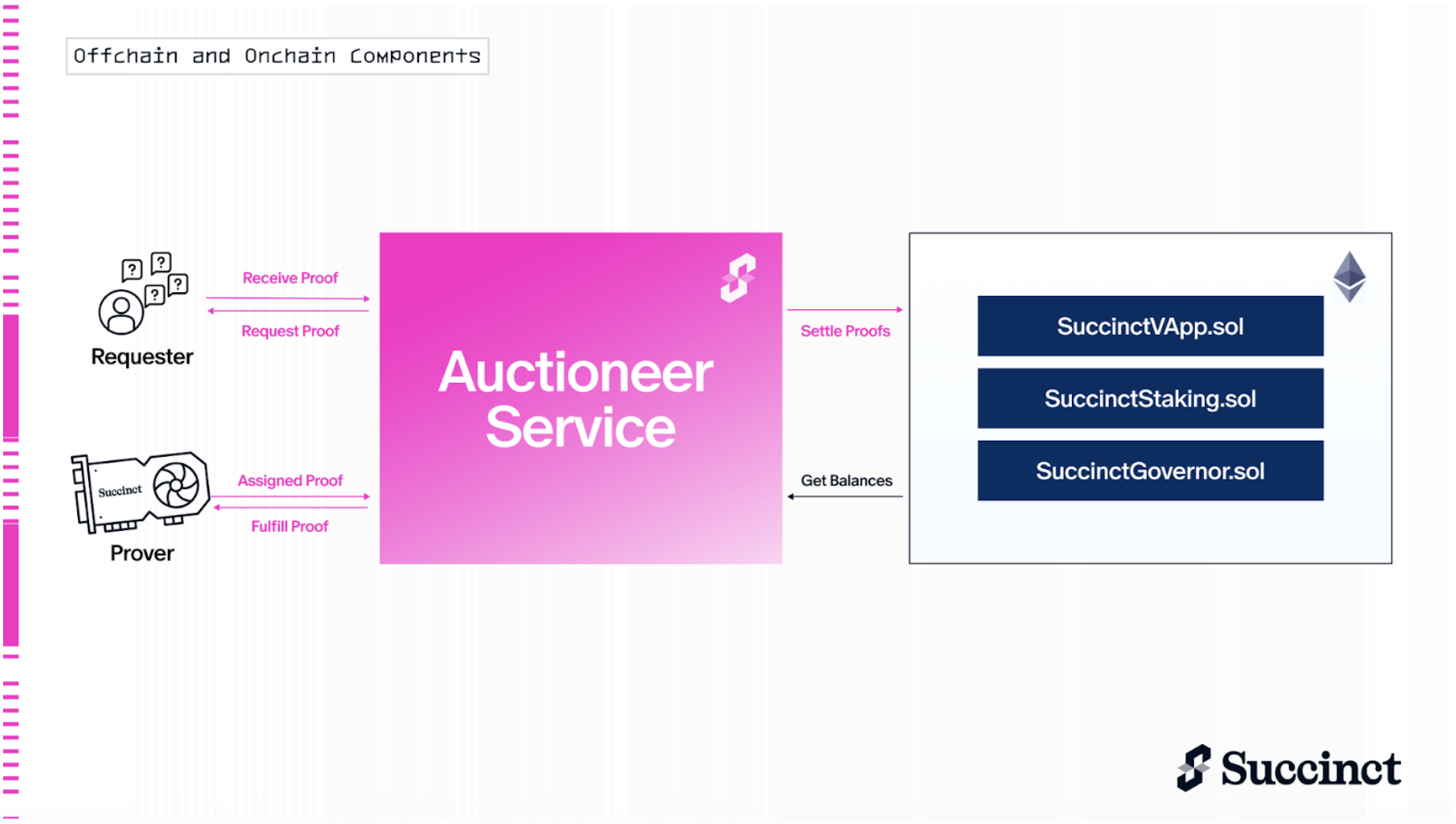Succinct is building the Succinct Prover Network: a protocol on Ethereum that offers a universal zero-knowledge proof generation service.
Until now, generating zero-knowledge proofs was complex, costly, and limited to narrow use cases, often requiring custom circuits and deep cryptographic knowledge. At the same time, there was no open marketplace for proving infrastructure.
Succinct addresses both sides of the problem:
Developers can use SP1, a general-purpose zkVM, to easily request zero-knowledge proofs for programs written in standard languages like Rust and C++, without needing to build custom circuits or understand cryptography.
These proof requests are handled by the Succinct Prover Network, a decentralized marketplace where anyone can contribute compute capacity and earn fees by generating proofs.
The PROVE token plays a central role in three different ways within the Succinct ecosystem:
Payment: The PROVE token serves as the medium of exchange within the network, facilitating transactions between developers and provers. Developers pay for proof generation services using $PROVE, while provers are compensated in PROVE tokens for delivering valid and timely proofs.
Security: The PROVE token can be staked to provide economic security within the protocol. Provers are required to stake PROVE tokens as a guarantee for timely proof submission. Failure to deliver proofs within the specified timeframe results in token slashing, thereby aligning incentives and maintaining network reliability. Similar to delegated proof of stake (dPoS) systems, token holders who are not provers can delegate their stake to provers to contribute more economic security to the reliable delivery of proofs.
Governance: The PROVE token grants governance rights to holders who stake their tokens, enabling them to actively participate in decentralized decision-making. Staked tokens carry voting power, allowing participants to propose and vote on critical protocol parameters, network upgrades, and long-term strategic direction.
Succinct consists of three main components:
Products & Infrastructure: Succinct provides a general-purpose zkVM and a decentralized prover network that enables developers to generate, verify, and outsource zero-knowledge proofs for any piece of software.. Core use cases include blockchain scaling, trustless bridging, and general purpose off-chain computation.
Technical Details: Succinct’s zkVM, SP1, implements a SNARK architecture that proves the correct execution of programs compiled for the RISC-V architecture. This allows any developer to write provable programs using ordinary languages like Rust. The zkVM also supports advanced features like recursion and support for WebAssembly (WASM) inputs. The prover network implements a two-sided marketplace for proofs generated using SP1 by matching proof requests with a global network of provers.
Consensus & Network Design: Succinct is not a standalone L1, but rather operates as a network of decentralized provers who stake the native token (PROVE) and compete to generate proofs. Similar to an L2 sequencer, a specialized off-chain auctioneer service handles core network operations, such as auctions and fulfillments. The integrity and availability of proofs are incentivized and enforced through cryptoeconomic mechanisms, including slashing and rewards. Rewards and slashing are settled on Ethereum, ensuring they are independently verifiable by all users.
The project has raised $56MM USD from two rounds of fundraising.
As at August 7, 2025, the total and max supply of PROVE is 1,000,000,000 and the circulating supply upon listing will be 195,000,000 (19.50% of the total token supply).
Key metrics (as at August 7th 2025)
1. What is Succinct?
Succinct is a protocol focused on verifiable computation using zero-knowledge proofs. It offers a general-purpose zkVM and a decentralized prover network that allows developers to generate and verify ZK proofs efficiently across blockchain environments. By abstracting the complexity of ZK infrastructure, Succinct enables trust-minimized interoperability, off-chain computation, and proof outsourcing, with the long-term goal of making cryptographic verifiability a standard feature in web3 systems.
1.1. Project Mission & Value Proposition:
Project Mission: Succinct’s mission is to make cryptographic verifiability a default feature of internet infrastructure. By simplifying access to zero-knowledge proof technology, Succinct aims to enable more secure, scalable, and interoperable systems across blockchains and beyond.
Value Proposition: Succinct enables developers to easily generate and verify zero-knowledge proofs without needing deep cryptographic expertise. Its decentralized prover network reduces the cost and complexity of proof generation, unlocking scalable, trustless applications such as cross-chain messaging, off-chain computation, and rollup verification. By abstracting ZK infrastructure, Succinct accelerates adoption of verifiable computation across the web3 ecosystem.
1.2. Project Key Highlights:
General-Purpose zkVM: Succinct offers a modular, general-purpose zero-knowledge virtual machine (zkVM) capable of running WASM programs, enabling broad developer use cases from bridging to off-chain computation.
Decentralized Prover Network: A permissionless network of provers generates ZK proofs and is incentivized through staking and rewards, promoting scalability, reliability, and decentralization.
Chain-Agnostic Infrastructure: Designed to work across multiple blockchains, Succinct supports use cases like trustless bridging, rollup verification, and interoperability.
Developer Abstraction: The protocol abstracts away the complexity of ZK tooling, allowing teams to integrate verifiable computation into applications without deep cryptographic knowledge.
Backed by Leading Investors: Succinct is supported by top-tier investors and has partnered with major ecosystems, signaling strong market confidence and alignment with web3 infrastructure needs.
1.3. Existing Products:
Network metrics for the Succinct Prover Network:
Processed over 5 million zero-knowledge (ZK) proofs during its testnet phase, representing more than 650 trillion RISC-V cycles submitted by external users.
More than 24,000 users have paid for ZK proofs on the testnet, generating over $250,000 in real USDC revenue in its first few days.
Currently, Succinct’s proving business already generates ~$2.5M in annual recurring revenue (ARR), which will be fully transitioned to the network following TGE.. See: https://explorer.succinct.xyz/
Developer metrics:
Succinct’s Rust SDK has surpassed 170,000 downloads, with more than 1,000 developers actively using it on a daily basis.
On GitHub, SP1, Succinct’s core proving software, has received over 1,400 stars, reflecting growing developer interest and visibility.
The project has also seen meaningful contributions from the broader open-source community, with more than 60 external developers contributing, including engineers from the Ethereum Foundation, Scroll, Polygon, Sovereign Labs, and other leading zero-knowledge and blockchain projects.
Broader ecosystem:
Over 30 VC-backed teams are actively leveraging the Succinct Prover Network for zero-knowledge proof generation.
This includes major players in the modular and Ethereum ecosystems such as Polygon, Celestia, Lido, Mantle, Avail, and Taiko, highlighting the network’s growing importance as critical infrastructure for scalable and trustless computation.

2. Token Sales and Economics
2.1. Token Distribution:
2.2. Token Release Schedule:
3. Risk Analysis:
3.1. Initial Circulating Retail:Institution Ratio:
3.2. Airdrop Cluster Analysis:
3.3. Initial TGE Main Bucket On-chain Wallets Addresses:
Disclaimer: This report is written before spot opening to trade, the liquidity token in the liquidity pool may be transferred while opening.
4. Roadmap & Updates:
4.1. Completed Milestones:
4.2. Current Roadmap:
Phase 1: Mainnet Rollout & Developer Ecosystem (Q3–Q4 2025)
Mainnet Launch: Get as many customers onboarded to the demand side of the network. Onboard world-class provers to make the network efficient and reliable.
PROVE Token Activation: Enable the token for mainnet payments, governance, and network incentives.
Developer-Centric Tools: Continue to improve tooling for all of our products, making it easier for developers to adopt ZK.
Phase 2: Cross‑Chain & Infrastructure Expansion (Q1–Q2 2026)
Ethereum & Ecosystem Integration: Deepen relationship with the Ethereum Foundation to prepare for Ethereum’s ZK scaling roadmap. Expand to new L2s in the wider Ethereum community.
New Crypto-Native Use Cases: Continue to expand ZK adoption beyond rollups by pursuing categories like ZK exchanges.
Non-Crypto Use‑Cases: Deploy “real-world” ZK applications (e.g., ZK identity, ZKML, attested media editing tools) leveraging SP1’s general-purpose capabilities.
Phase 3: Faster and Newer Versions of SP1, and Beyond (Mid–Late 2026)
4.3. Commercial and Business Development Progress:
Polygon (AggLayer and Katana): Polygon is a leading blockchain with a range of solutions for consumers and developers. Their AggLayer product connects fragmented liquidity across chains, and it’s secured by pessimistic proofs from Succinct. Katana is a new DeFi-first L2 incubated by Polygon. Through Succinct’s validity proofs, Katana became a ZK rollup.
Celestia: Celestia provides modular DA for blockchains, saving time and money for rollup teams. They use SP1 to secure the production Blobstream DA bridge, which connects Celestia to settlement layers like Ethereum.
Avail: Avail is building an interoperability layer for Web3. They use SP1 to secure their production DA and token bridges that connect Avail to Ethereum.
Mantle: Mantle is a leading L2 with institutional-grade functionality. They are using OP Succinct to become a ZK rollup.
Hibachi: Hibachi is building the endgame exchange. They're using SP1 to prove their CLOB, creating a fast and private trading experience.
Lido: Lido is the largest liquid staking protocol. They use SP1 as a ZK coprocessor to trustlessly secure their Accounting Oracle.
Taiko: Taiko is a based rollup that is scaling Ethereum with ZK proofs. They use SP1 in a multi-proof setup to prove their mainnet blocks.
Galxe: Galxe is onboarding the world to Web3. They use SP1 in production to power their verifiable raffles.
Phala: Phala is pioneering the future of verifiable AI agents. They use OP Succinct to prove their mainnet blocks.
Alpen: Alpen is building a programmable L2 for Bitcoin. They use SP1 to power their ZK-enabled infrastructure.
Morph: Morph is building the global consumer layer. They use SP1 in production to power their ZK fault proofs.
Nitro: Termina is accelerating Solana scaling. They are building a zero-knowledge SVM with SP1.
Scalerize: Scalerize is building a based rollup stack on Solana. With SP1-powered fault proofs, their stack is able to support multiple execution environments at scale.
Sovereign: Sovereign is building an application-specific rollup-development toolchain. Their SDK supports SP1 as a primary zkVM prover for securing these rollups.
5. Community:
X (Twitter): Succinct Labs, Succinct Foundation
Blog: Succinct Labs, Succinct Foundation
